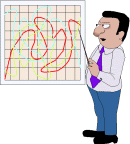

Synoptic Charts
 With an understanding of how the air moves and how clouds and rain form, much prediction can be made by simply observing the sky overhead, observing wind direction and noting the temperature and humidity of the air. But to be able to predict and forecast weather it is necessary to understand the development of weather systems such as depressions and anticyclones by means of isobar plots. Meteorologists plot isobaric patterns on synoptic charts.
With an understanding of how the air moves and how clouds and rain form, much prediction can be made by simply observing the sky overhead, observing wind direction and noting the temperature and humidity of the air. But to be able to predict and forecast weather it is necessary to understand the development of weather systems such as depressions and anticyclones by means of isobar plots. Meteorologists plot isobaric patterns on synoptic charts.
The first stage in preparing a synoptic chart is to chart the position of each meteorological station. These are marked by a small circle. The weather report for each station is then plotted in and around the circle, documenting the station's recorded temperature, rainfall, pressure, wind speed and direction, and cloud coverage. The station circle and various elements of the weather make up weather symbols.
When plotting of the meteorological observations is completed, the forecaster then uses the values of pressure at all the stations to identify isobars - lines of equal pressure. The completed synoptic chart with symbols and isobars usually reveal a few standard weather patterns. The positions of fronts and regions of low and high pressure can also be plotted on the synoptic chart, which show the weather conditions of different areas at a particular time. With skill and experience the meteorologist can use the synoptic chart to forecast the weather up to 24 to 48 hours ahead. Synoptic charts are updated at least every six hours, plotting new weather symbols and isobars, in order that the weather forecast can remain as accurate as possible.
 | Simple synoptic chart |
Websites
Other topics
• Synoptic Charts
• Weather Charts
• Weather Charts
• UK Weather Forecasts
• Met. Office
• Introduction to Weather
• Anticyclones
• Beaufort Scale
• Cirrus Clouds
• Clouds
• Cold Fronts
• Condensation
• Convection
• Cooling Air
• Cumulonimbus Clouds
• Cumulus Clouds
• Depressions
• Dew
• Dew Point
• Energy
• Evaporation
• Fog
• Forecasting
• Fronts
• Frost
• Humidity
• Hurricanes
• Isobars
• Measuring Weather
• Meteorology
• Monsoons
• Movement of Air
• Occluded Fronts
• Precipitation
• Pressure
• Sea Breeze
• Stability of Air
• Stratus Clouds
• Sunshine
• Synoptic Charts
• Temperature
• Thunderstorms
• Tornadoes
• Uplift of Air
• Warm Fronts
• Water Cycle
• Weather Symbols
• Wind
 Print Topic
Print Topic